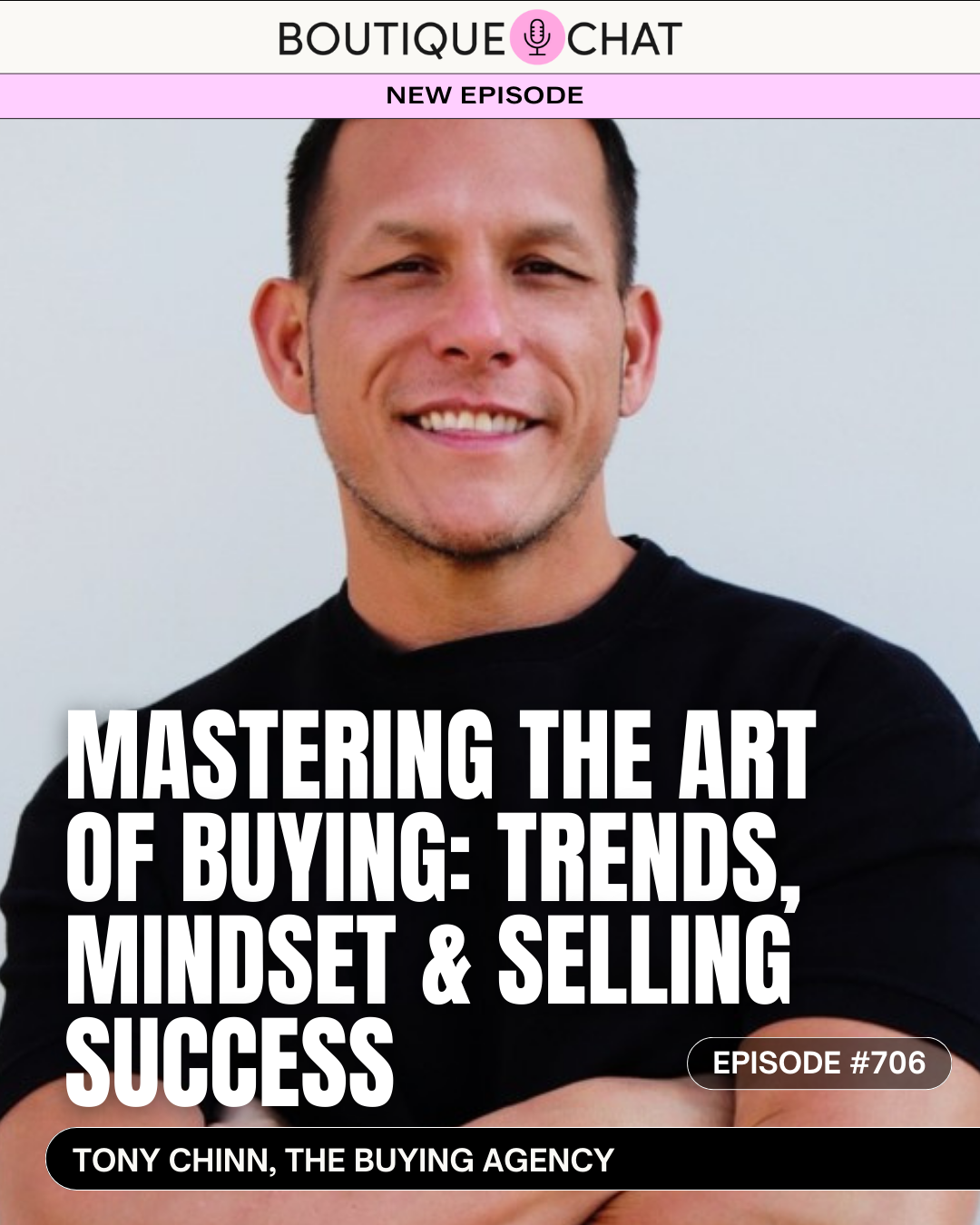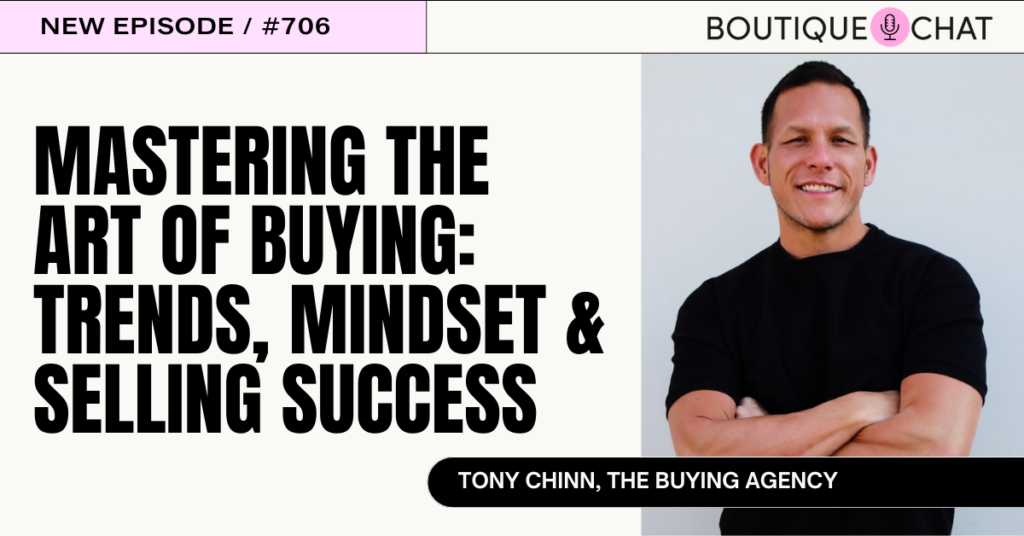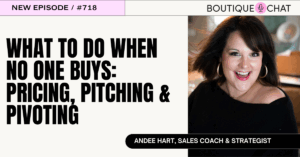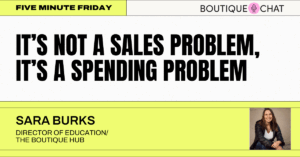

APPLE PODCAST | SPOTIFY | YOUTUBE
What does it take to become an entrepreneurial powerhouse in the retail world? Tony Chinn, a seasoned retail expert, joins us today to share his incredible journey from starting as a greeter at Guess to launching his own successful entrepreneurial venture. With experience at iconic brands like BB, Kitson, Forever 21, Agassi, and Akira, Tony’s story is a testament to the power of intention and vision boards when it comes to achieving lasting success. Listen in to hear practical advice for retailers and insights into maximizing retail success.

Mastering the Art of Buying: Trends, Mindset & Selling Success
Managing inventory is one of the trickiest parts of running a retail business. Knowing when to move products, how to price them, and what to bring in next can make all the difference between a thriving business and one that’s stuck with unsold stock.
How to Move Inventory Quickly
One of the biggest challenges retailers face is keeping inventory moving. According to expert buyer Tony Chinn, if something hasn’t sold within the first month, something is off. That means it might be time to reshoot product photos, adjust pricing, or change how it’s displayed. Instead of marking it down immediately, try a pricing adjustment—if your sweet spot is $39, but you initially priced it at $49, bring it down to $39 without calling it a sale. This way, it remains a regular-priced new arrival, and you’re not constantly training your customers to wait for discounts.
The key is to avoid inventory sitting too long. By the time a product hits the 90-day mark, you’re often forced to deeply discount it or even give it away. Instead, work through your inventory in phases—analyzing products at the 30-day and 60-day marks to take action before reaching that point.
Preparing for Market: The Power of Data-Driven Buying
Heading to market is one of the most exciting parts of retail, but it’s easy to get overwhelmed by all the options. The best way to prepare? Use historical data.
Before attending a show, review your sales history from the same period last year. Break it down by vendor and category—who were your top 10 vendors? What were your best-selling categories? This gives you a roadmap of which vendors you need to visit first so you can secure the products your customers already love before exploring new options.
That said, historical data is a guide, not a rulebook. Market trends shift, and what sold well last year might not be the hot item this year. If a trend like shackets dominated last fall but feels absent from this year’s offerings, the market may be signaling that it’s time to invest in other categories, like long-sleeve tops or trending colors.
Reading Market Trends in Real Time
One of the biggest advantages of attending market is getting a sneak peek at what’s coming. It’s the closest thing to a crystal ball for the next six months of retail trends. For example, Tony noted that at the most recent Vegas market, leopard print was everywhere—not just in vendor displays, but worn by buyers themselves. This is a huge indicator that leopard is making a comeback, and retailers who pick up on this early can stay ahead of the curve.
When shopping at market, don’t just look at what’s available—observe what people are wearing and talking about. That’s often the best predictor of what will sell in the coming season.
Adapting Trends to Your Local Market
A trend might be booming in big cities, but what if you’re in a smaller town where trends take longer to catch on? Tony suggests taking a cautious approach—dip your toes into the trend with a few pieces instead of going all in. Retailers need to recognize the difference between early adopters and mass-market trends and adjust their buying strategies accordingly.
Another key strategy? Always consider the end customer. It’s easy to get caught up in the excitement of market, but just because something looks great on a hanger doesn’t mean it will sell. Ask yourself: Who is wearing this? If you can’t picture your ideal customer in it, it might not be the right buy for your store.
The Benefits of Working with a Buyer
For many retailers, working with a professional buyer can be a game-changer. Buying is a team sport—having multiple perspectives can prevent a store’s selection from becoming one-dimensional. A professional buyer brings fresh eyes, industry knowledge, and connections to help retailers find the best products.
If you’re struggling to find good products, don’t worry—they’re out there. Buyers have access to in-stock options every single day and can help you discover items that fit your brand and customer base. Additionally, working with a buyer can help you scale strategically—whether you’re a small boutique looking for quick wins or a larger retailer making long-term inventory decisions.
When to Experiment with Higher Price Points
Another common question among retailers is when to start introducing higher-end apparel into their mix. The answer depends on your specific customer base, but Tony advises that having a mix of high and low price points is often the best approach. This strategy, which he learned from working at Kitson, ensures you’re offering a variety of options without alienating your core customers.
If you’re thinking about testing higher price points, start small. Bring in a handful of premium items and see how your customers respond. If they sell well, you can gradually expand that category over time.
In This Episode
- Tony Chinn: Website | Instagram
- Boutique Summit 2025
- Retail Bootcamp
- 2025 Boutique Boss Planner
- Join The Boutique Hub
- Ashley Alderson: Instagram
- The Boutique Hub: Website | Facebook | Instagram | Pinterest | TikTok | YouTube
Let’s Connect #AskAshley
- Have a question or guest recommendation? Let us know your feedback directly here!
- Do you love the Boutique Chat Podcast?! Subscribe to our podcast and after that, leave us a review on iTunes Apple Podcasts here!
Must Have Resources
- The Boutique Hub: Website | Facebook | Instagram | Pinterest | TikTok | YouTube
- Profit First by Mike Michalowicz
- 2025 Boutique Boss Planner
- Boutique Summit 2025
- Small Business Marketing Handbook
- Small Business Hiring Handbook
- Brand Owner Basics Masterclass
- Tradeshow Marketing Handbook
- 2024 Trade Show Calendar
- Boutique Hub Black
- Hubventory.com
Recent Posts:
- What to Do When No One Buys: Pricing, Pitching & Pivoting
 What if sales didn’t have to be about being pushy or intimidating, but instead about solving problems and making life better? Join us as we explore this concept with our guest, Andee Hart, who transformed her corporate sales expertise into a flourishing candle business during the pandemic. Andee’s inspiring journey is a masterclass in differentiation and tenacity, from how she successfully stood out in a crowded market to how she scaled her business to hundreds of boutiques.
What if sales didn’t have to be about being pushy or intimidating, but instead about solving problems and making life better? Join us as we explore this concept with our guest, Andee Hart, who transformed her corporate sales expertise into a flourishing candle business during the pandemic. Andee’s inspiring journey is a masterclass in differentiation and tenacity, from how she successfully stood out in a crowded market to how she scaled her business to hundreds of boutiques. - Top 10 Mistakes Retailers Make (And How Retail Bootcamp Helps You Avoid Them)
 Running a boutique business can be one of the most rewarding—and challenging—adventures. Whether you’re just starting your boutique or you’ve been in business for years, it’s easy to fall into common traps that hold your growth back. The good news? You’re not alone—and you don’t have to figure it out on your own either. That’s where Retail Bootcamp comes in. This proven boutique coaching program is designed to help boutique owners like you grow smarter, more profitably, and with a clear plan in place.
Running a boutique business can be one of the most rewarding—and challenging—adventures. Whether you’re just starting your boutique or you’ve been in business for years, it’s easy to fall into common traps that hold your growth back. The good news? You’re not alone—and you don’t have to figure it out on your own either. That’s where Retail Bootcamp comes in. This proven boutique coaching program is designed to help boutique owners like you grow smarter, more profitably, and with a clear plan in place. - Slow Sales? Ask These 5 Why’s Before You Panic
 Is your cash flow feeling tight but you’re still not paying yourself? In this episode of Five Minute Friday, Sara breaks down one of the most common retail traps: tying up cash in things that don’t bring you a return. From unnecessary trips to market to unused apps, pretty packaging, and impulse inventory buys, these hidden money leaks could be holding your business (and paycheck!) back.
Is your cash flow feeling tight but you’re still not paying yourself? In this episode of Five Minute Friday, Sara breaks down one of the most common retail traps: tying up cash in things that don’t bring you a return. From unnecessary trips to market to unused apps, pretty packaging, and impulse inventory buys, these hidden money leaks could be holding your business (and paycheck!) back.





